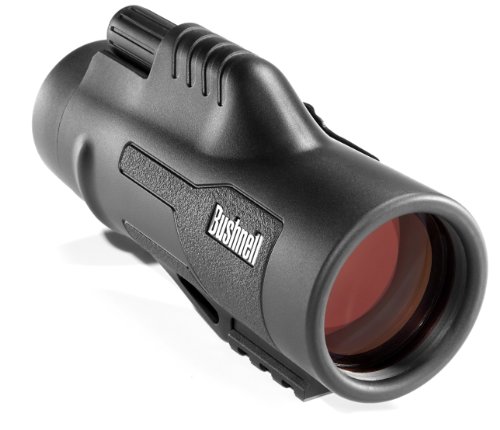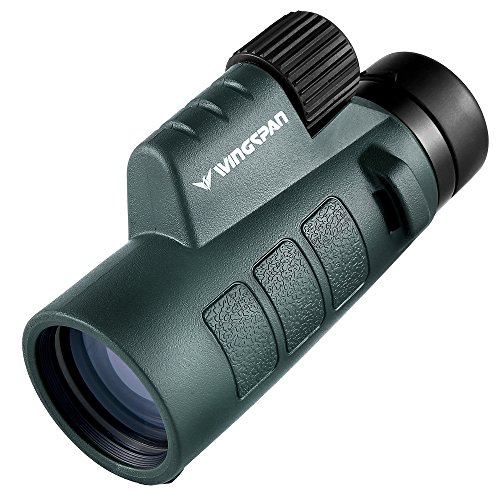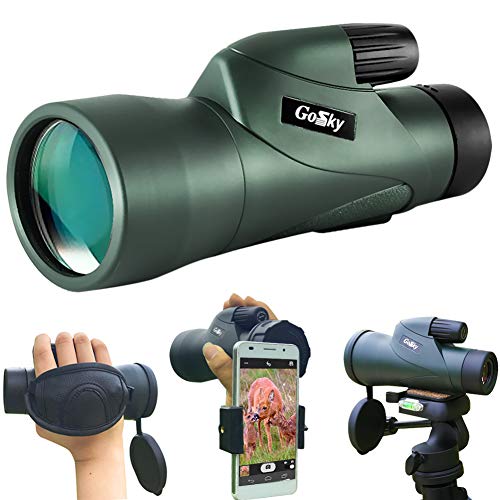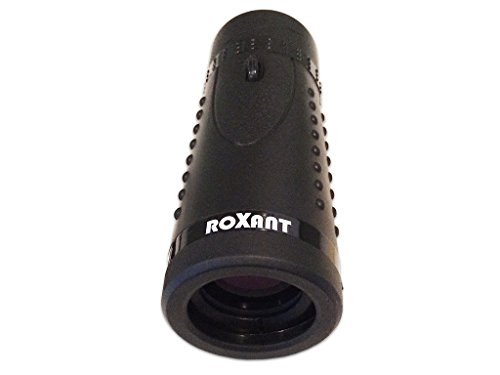10 Best Monoculars for Bird-Watching of 2025 – Reviews & Top Picks
Last Updated on
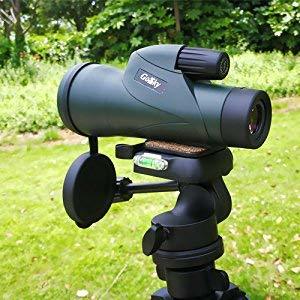
When it comes to birding, nothing beats a good old-fashioned pair of binoculars. Right?
Well, that depends on who you ask. Although binoculars are associated as a birder’s tool of choice, there are many out there who’d disagree.
Using a monocular or spotting scope can be just as advantageous— if not more — than using a set of binoculars. They’re sleeker and lightweight, making them easier to wield than traditional binoculars. Spotting scopes are also much more convenient to carry around, meaning they’ll spend less time in your glovebox and more time in use.
But just like binoculars, there’s a whole bunch of different options to choose from. So how will you know which is best for you?
Fortunately, we’ve gone through and tested several varieties and put together a list of our favorites. And while these aren’t fully exhaustive of the available market, this list will give you a good idea of what’s out there and what to look for.

A Look at Our Favorite Products of 2025
| Image | Product | Details | ||
|---|---|---|---|---|
| Best Overall |
 |
Bushnell Legend 10x42 |
|
CHECK PRICE |
| Best Value |
 |
Wingspan Optics 8X42 |
|
CHECK PRICE |
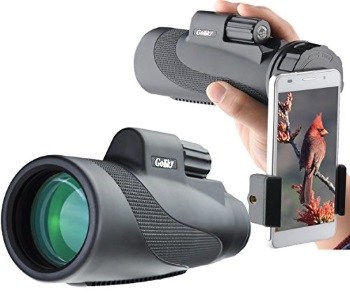 |
Gosky 12×55 |
|
CHECK PRICE | |
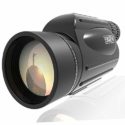 |
Emarth High Power 10-30X50 Zoom |
|
CHECK PRICE | |
 |
SOLOMARK 12×50 |
|
CHECK PRICE |
The 10 Best Monoculars for Bird Watching
1. Bushnell Legend 10×42 Monocular – Best Overall
It wasn’t really all that hard to give the Bushnell Legend our top pick for birding monoculars. This one really is the Cadillac of the competition, outclassing the other monoculars in just about every department. Except for one, which is price. In this case, you’re also paying for a Cadillac. If you take birding seriously, you’ll want the Cadillac.
The Legend comes with the kind of high-grade optics common to quality spotting scopes intended for long ranges. It’s got low-dispersion glass and multi-coated optics, and the BAK-4 prism is phase coated. All of these are designed to reduce blurs, distortions, and color aberrations common to high magnifications at long ranges. Bushnell puts them into a monocular for birding and made the entire thing waterproof so water wouldn’t seep in and ruin the image. It is the cream of the crop.
It’s a little bulky as a monocular but, more than that, you will pay for that quality. But, you probably figured that.
- High-grade optics
- Sharp, clear colors
- Pricey
- Bulky
2. Wingspan Optics 8X42 Bird Monocular – Best Value
Wingspan’s Optics Outdoorsman is a great value monocular for birding. It delivers a nice, sharp image in a durable frame at a cost that makes it a good investment for any budget. Without question, it’s our “best for the money” birding monocular.
We like its portability and the ease with which you can focus it with one hand. It’s not a lightning-fast focus, but a focus that lets you get the job done properly. There’s less futzing around with it than a traditional pair of binoculars. It won’t deliver the crispness of the Bushnell, but if you want to know the kind of woodpecker you’re seeing, it’ll get you the right kind of image for an identification.
It’s a bit bulky for a monocular, which is undesirable for a highly portable optic unit. We also felt like the lens cap was, oh, not all that well designed. For what you’re paying, however, it’s a great value.
- Easy and efficient use
- Portable
- Great value
- Sharp images
- Bulkier than other monoculars
- Accessories are hot garbage
3. Gosky 12×55 Monocular for Bird Watching
Don’t let its ranking fool you. Gosky’s 12×55 monocular is a good tool for birding. It just lacks the Bushnell’s high-end optics and the Wingspan’s value as a purchase. And, someone has to be in the bottom ranking, right?
The Gosky is a durable monocular with a large objective lens that captures a lot of light. That makes it a little better in low-light conditions (the Bushnell compensates with vastly superior optics).
What we didn’t like was that it’s a bit overpriced for what it delivers. You can get similar quality for much less money. It’s also a little underpowered compared to its competitors. This monocular can get you a nice, crisp image but it can’t quite do it at the range you might like.
- Durable
- Great in low-light conditions
- Good value
- Heavy
- Falloff in quality at long range
4. Emarth High Power 10-30X50 Zoom Monocular
The first thing that stood out to us when reviewing the Emarth is its long eye relief. It has an eye relief of 19.5mm, making it one of the absolute best options for those who wear corrective lenses. But it’s not just the eye relief that makes this worth checking out.
It’s built with a BAK4 crystal prism and an FMC 50mm objective lens, giving it a picture to rival many Porro systems. And it’s built to last. It’s a nitrogen-purged unit for true fog and waterproofing. Plus, if anything goes wrong, you’ll get lifetime customer service with Emarth.
We really wish it had a strap attachment point somewhere on the actual scope though. And the tripod mount could use a bit of work. It feels flimsy and breakable when compared to the rest of the body.
- Huge eye relief
- Rivals many Porro systems with clarity
- Lifetime customer service
- Nitrogen purged
- Missing strap attachment point
- Tripod mount could be sturdier
5. SOLOMARK 12×50 High Power Monocular
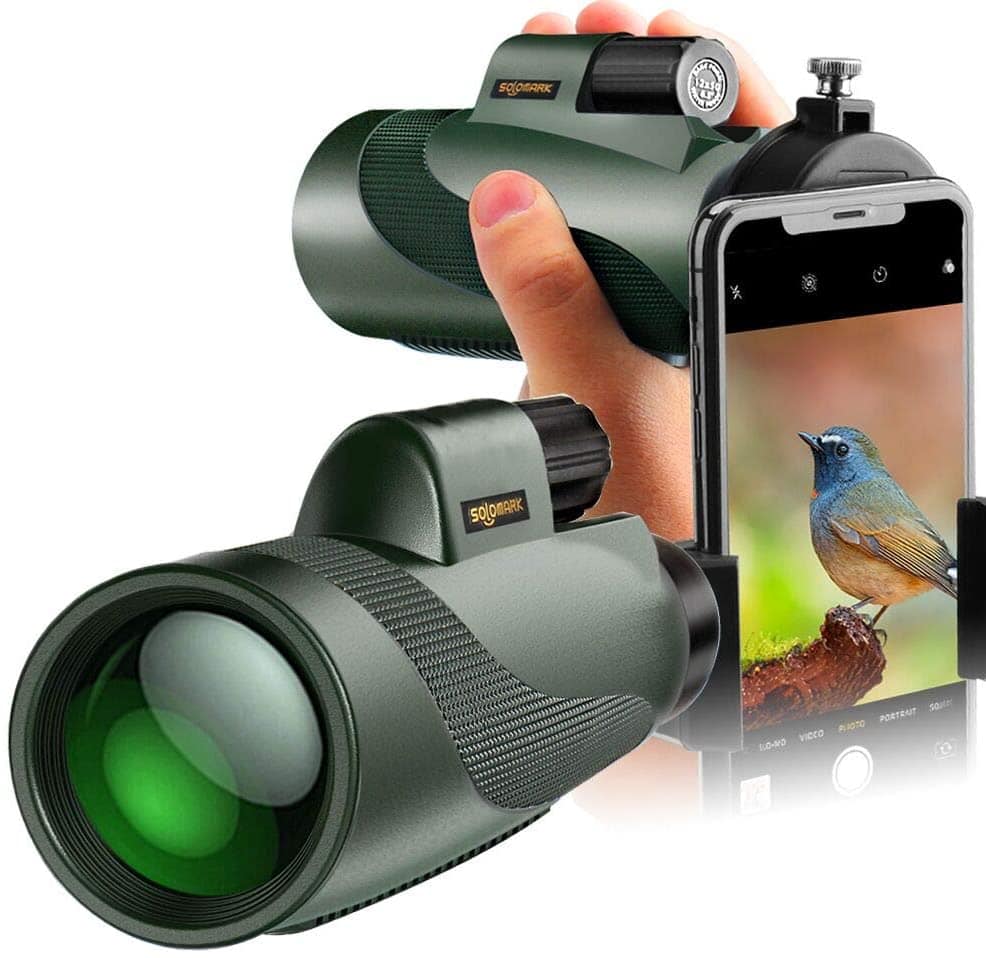
Another entry in the long eye relief club is the SOLOMARK monocular. It’s not quite as lengthy as the Emarth but glasses wearers should have little issue with the 17mm relief provided. The lens has a fully multi-coated green film and the optics are BAK4 prism.
The SOLOMARK is also built like a tank. It’s been nitrogen purged and O-ring sealed to prevent any water, dust, or debris from affecting the operation of the scope. And the SOLOMARK’s been banded with rubber armor to prevent any drop or shock damage.
However, this thing is big and heavy. While it provides quality performance, the sheer size may make you wonder why you aren’t just using binos.
- Great eye relief
- Very sturdy
- Good optics
- Too big and heavy for a monocular
6. Wingspan Optics Titan 12X50 High Powered Monocular
The Wingspan Optics Titan might just be one of the most rugged and robust monoculars we’ve ever used. It’s waterproof, fog-proof, climate-proof, drop-proof, and dang near bomb-proof! And if it ever does break, Wingspan Optics provides a lifetime guarantee.
But it’s not just durable, it’s a solid monocular as well. It’s got a standard BAK4 prism system with a 12x magnification. However, we find the eye relief to be a bit short at only 14mm. Those who wear corrective lenses may have a bit of trouble maximizing the true potential of this scope.
- Lifetime guarantee if it breaks
- Good gift for a kid getting into optics
- Short eye relief
7. Aurosports 10-30×40 Zoom Monocular
Normally, when it comes to optics, you get what you pay for. But such isn’t the case for the Aurosports 10-30×40. For as cheap as it is, you’d expect many more problems than it actually has.
It’s compact enough to fit within your pocket, has a BAK4 prism system, and FMC broadband green and HD blue film for better eye relief and clarity. It’s even waterproof, up to a point. The manufacturers do say not to leave in water for prolonged periods….
The biggest gripe we have is that it’s a bit tricky to get the focus just right. And the directions aren’t so clear on how to do this. One thing that many people miss when operating this monocular is that you need to use this in a manner similar to a spyglass. Once extended, things will become much easier.
- Great for those on a tight budget
- Decent enough optics
- Confusing to focus
8. Vivreal Monocular Telescope – 12X55
If you’re looking for another decent birding scope, check out the Vivreal monocular. It’s got a 12x magnification power, making it great for viewing things at longer distances. The monocular is also designed with a BAK-4 Prism and multi-layer green film lens giving the scope a bright, clear view.
But the biggest issue lies with its magnification power. It’s just too strong. Zooming in without using the tripod becomes a veritable nightmare of shakiness, and there’s really no way to get a clear picture. That would be alright if the tripod was of better quality, but it’s not.
- Strong magnification
- BAK4 prism system
- Tripod is of questionable quality
9. Summit Tools HD Digital Night Vision Monocular
The Summit Tools HD Night Vision monocular sounds like a pretty good steal. It’s built tough out of hardened plastic and is water-resistant — not waterproof. The monocular’s got a 6x magnification and larger objective for the best clear views. Oh, and it’s got night vision that you can record and take still photos with!
And we’ve got to say, it does provide a fairly clear image. The HD camera is actually pretty decent and can be set up on a tripod for better quality photos.
But the real issue we have is the distance range with this scope. Although the product boasts up to 1150 feet of clarity, we couldn’t get any clear pictures out past distances of 100 feet. And this isn’t a cheap monocular either. If you’re looking for extremely short range night vision, this could work as it is cheaper than most night vision devices. However, if you need a longer distance range, opt for another model.
- Clear views at close range
- Night vision camera and video recorder
- Very short distance range
- Expensive
10. ROXANT Grip Scope High Definition Wide View Monocular
This ROXANT grip scope gave us some pretty high hopes at first glance. It’s affordable, fully multi-coated optical glass with a BAK4 Prism setup and wide angle lens. However, things took a turn for the worse when we actually examined the magnification power.
While this claims to have a 6x magnification, the scope is only pushing 4-5x at best. It just doesn’t have the power you’re expecting it to have. Also, it’s not the most robust scope available. One small drop and you’ll be looking to purchase another.
However, if you’re looking for a cheap novelty gift, this ROXANT grip scope serves a great purpose. Otherwise, save your money and invest in something a little more high quality.
- Affordable
- The magnification of this scope is nowhere near as advertised

Buyer’s Guide: Choosing the Best Monoculars for Bird Watching
Now that you’ve read our reviews, you may feel like you’ve opened the door to what to look for in a birding scope. But what else do you need to know to make the right decision?
We’ve pieced together a short buyer’s guide based on our review criteria. We hope that you can use the information in it to choose the right monocular for your birding kit.
Budget
We don’t normally advise you to start with setting a budget, but in the case of a birding monocular, you can do just that. If you’re using a monocular, unlike a spotting scope that has you looking at objects far away using high magnifications, you’ve opted for mobility over range. You can still pay for all the features that you would need to make buying a scope worthwhile, but you can also go light on these because you don’t have to worry so much about getting a crisp image from several hundred yards away. Figure out how much you want to spend, but be willing to adjust. That is, know what you want a monocular for and spend accordingly.
Magnification
This is another important factor you need to consider. How close are you trying to zoom in? If you’re birding, you might want to consider a higher magnification power in order to get the best details out of your target. But you’ll need to keep in mind that higher magnification powers often lead to shakier and unstable images. Using a tripod at increased magnifications is recommended to get the best shots.
On the other hand, if you’re out hiking, you might not want a higher magnification option. A 4x-6x could be all that you need to take in the great scenery.
Field of View
This goes hand-in-hand with magnification. Generally speaking, the higher the magnification power, the narrower your field of vision will be. A narrow field of vision may sound like a bad thing, but in all reality, it can be great depending on what your target is. If you’re birding or doing close-up photography, narrow fields of view can give you the sharpest and clearest images.
However, if you’ll be primarily scouting, hunting, or looking at landscapes, consider a wider field of vision.
Conditions
When buying something, it’s always smart to start out by assessing where and how you’re going to use it. For a birding monocular, that means figuring out whether or not they’ll be much light and whether you’ll be in wet conditions.
If you’re going to use it primarily in low-light conditions, maybe at dusk to watch owls, you’ll want a monocular with a larger lens. That’ll make it larger and a bit clumsier to use, but the big lens will also gather in more light and account for the dim environment.
Wet environments mean you should look to monoculars that are water- and fog-resistant. You really want an optics chamber sealed off from environmental conditions. If the air around you is dry, that’s less important, but condensation is a real issue if you drop it in a stream and water gets inside it.
Optics
Some of the features that help reduce glare, blur, and distortion at really long ranges aren’t such a big deal at a shorter range, but birding requires that you observe details. So, you’ll want features that help enhance the sharpness of the final image. That would include things like coated lenses and a prism.
Coated lenses help reduce the light lost to reflected waves. This will help images come out sharper and more colorful. There is a range of different kinds of coatings from single coats to multiple-layer coatings. Generally speaking, the more coats the higher the quality of the image.
Most monoculars use Porro prisms — such as the BAK4 system. These produce colorful images with more depth. They are most commonly found in monoculars at the lower end of the magnification range.
Roof prisms, which produce more compact, flatter images, are often found in monoculars with higher magnification.
Size Matters
The entire point of using a monocular is that it’s more compact and easier to use than the alternatives, so size will necessarily play a role in choosing which one is right for you. Find one that is easy to hold and move into place with your hands, but isn’t a burden to wear around your neck while moving.


Conclusion
Bushnell’s Legend was far and away our favorite monocular for bird watching in our reviews. The optics are top-of-the-line and deliver sharp, colorful images under all kinds of conditions. It’s the Cadillac of birding monoculars, and that also means paying for it. The Wingspan Optics Outdoorsman was our “Best for the Money” choice. It does the most for the amount of money you pay for it. Considering how much it costs, it’s quite the bargain. The Gosky is a good birding monocular, but overpriced considering its quality and limited power.
We hope you enjoyed our reviews and found them useful. If you go on looking for your birding monocular, we hope our buyer’s guide provided a lot of meat to chew over in your search. We wish you the best of luck in your purchase and lots of happy memories as you go out logging new and interesting species.
Table of Contents
- A Look at Our Favorite Products of 2025
- The 10 Best Monoculars for Bird Watching
- 1. Bushnell Legend 10×42 Monocular – Best Overall
- 2. Wingspan Optics 8X42 Bird Monocular – Best Value
- 3. Gosky 12×55 Monocular for Bird Watching
- 4. Emarth High Power 10-30X50 Zoom Monocular
- 5. SOLOMARK 12×50 High Power Monocular
- 6. Wingspan Optics Titan 12X50 High Powered Monocular
- 7. Aurosports 10-30×40 Zoom Monocular
- 8. Vivreal Monocular Telescope – 12X55
- 9. Summit Tools HD Digital Night Vision Monocular
- 10. ROXANT Grip Scope High Definition Wide View Monocular
- Buyer’s Guide: Choosing the Best Monoculars for Bird Watching
- Conclusion
About the Author Robert Sparks
Robert’s obsession with all things optical started early in life, when his optician father would bring home prototypes for Robert to play with. Nowadays, Robert is dedicated to helping others find the right optics for their needs. His hobbies include astronomy, astrophysics, and model building. Originally from Newark, NJ, he resides in Santa Fe, New Mexico, where the nighttime skies are filled with glittering stars.
Related Articles:
How to Choose Binoculars for Bird Watching: 10 Expert Tips
How to Clean a Refractor Telescope: Step-by-Step Guide
How to Clean a Telescope Eyepiece: Step-by-Step Guide
How to Clean a Rifle Scope: 8 Expert Tips
Monocular vs Telescope: Differences Explained (With Pictures)
What Is a Monocular Used For? 8 Common Functions
How to Clean a Telescope Mirror: 8 Expert Tips
Brightfield vs Phase Contrast Microscopy: The Differences Explained




